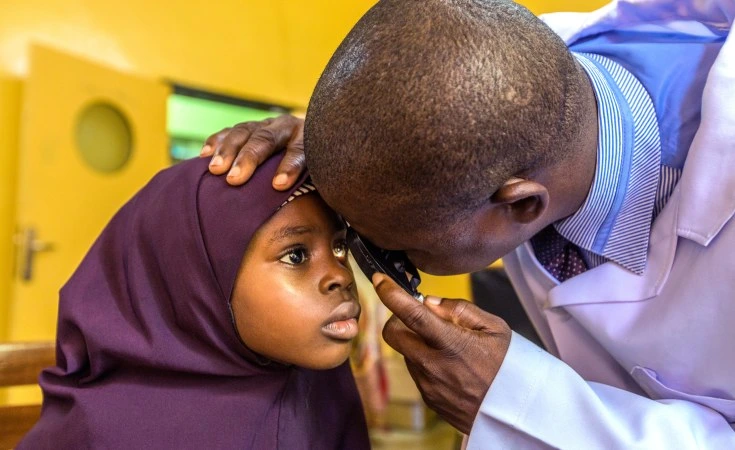Author's details
- Dr. Khashau Eleburuike
- MBBS (Ilorin) MSc. Global Health Karolinska Institute.
- Resident doctor in family medicine in Northern Sweden.
Reviewer's details
- Dr. Melchizedek I. Munaje
- MBBS, MWACS, FMCOph
- Consultant Ophthalmologist, ECWA Eye Hospital, Kano, Nigeria

- Date Published: 2025-09-17
- Date Updated: 2025-09-17
Uncorrected refractive errors in children
What is a refractive error?
Refractive error is when the eye does not focus light correctly on the back of the eye called the retina, so things look blurry. The common types are:
- Myopia (short-sight) — distant things look blurry (child sits very close to the TV or blackboard).
- Hyperopia (long-sight) near things may be blurry, or the child may have headaches or eye strain.
- Astigmatism — vision is blurred or distorted at any distance because some eye structures, like the cornea and lens, are not bending the light to focus on the retina perfectly.
A simple pair of spectacles (glasses) usually correct these problems quickly and safely.
(Refractive errors are the leading correctable cause of vision problems in children worldwide.)
Why this matters for your child
- Poor vision can make learning at school harder, reduce confidence, and limit social activities. Studies in Africa show measurable drops in school performance and quality of life when refractive errors are not treated.
- Many children do not complain because they think what they see is normal — so parents and teachers must watch for signs.
Signs to watch for (may be subtle)
A child may have a refractive error if you notice any of these:
- Squinting, blinking a lot, or covering one eye.
- Sitting very close to the TV or holding books/screens very close.
- Poor reading or school performance, slow homework, losing place when reading.
- Frequent headaches, eye rubbing, or complaints of eye pain or tiredness.
- Tilting the head to look or avoiding ball games and outdoor play.
If you see any of these, arrange an eye check.
How is it diagnosed?
- An eye health worker / optometrist / ophthalmic clinical officer measures how well each eye sees and uses simple tests (eye charts, retinoscopy, or an autorefractor). For young children, the eye may be examined after dilating drops, so measurements are accurate. The test often takes only 10–20 minutes.
Treatment — simple and effective
- Spectacles (glasses) are the most common and effective treatment. Correct-fit glasses usually restore clear vision immediately. Programs in low-resource settings have shown large improvements in children’s vision, comfort and school participation when glasses are provided.
- For some children (rarely), other treatments or referrals are needed — an eye specialist will advise.
Where to get help in your community
- School eye screening programmes — many schools have periodic checks; ask teachers or the school nurse.
- Local health center or district eye clinic — staffed by an eye nurse, ophthalmic officer or optometrist.
- NGO outreach camps / eye camps — many ministries of health and NGOs run low-cost or free spectacle distribution programmes.
If you are not sure where, ask at your primary health center or district hospital.
Cost, access and spectacles for children
- Spectacles for children can be low-cost or provided free in many programmes — but uptake is sometimes low because of cost, misconceptions, or stigma. If cost is a problem, ask about local charity programmes or school donation schemes. Evidence shows that when children receive comfortable, well-fitted spectacles, they keep using them and school outcomes improve.
Caring for your child’s glasses
- Teach your child to store glasses in a case and clean them with soft cloth.
- Check the fit regularly — children’s faces grow, and lenses may need adjustment.
- Replace broken frames quickly so the child continues to wear their glasses.
Common questions (brief)
Will glasses make my child’s eyes worse?
No. Glasses help the child see clearly and do not harm the eyes. Not wearing needed glasses can worsen learning and quality of life.
My child is young — can they wear glasses?
Yes — babies and toddlers can wear corrective spectacles that are specially fitted. Early correction is important for development, and it prevents another eye problem called amblyopia
What if the child refuses to wear glasses?
Try positive reinforcement: show how much easier schoolwork or play is; get a comfortable frame; involve teachers to encourage use.
When to seek urgent care
- If a child has sudden loss of vision, a painful red eye, trauma to the eye, or signs of infection (pus, swelling, high fever), seek immediate care at the nearest hospital.
Take-home message
Uncorrected refractive errors are common, easy to diagnose, and simple to treat with glasses. Early detection (school screening or a clinic check) helps a child learn, play and grow with confidence. If you see any worrying signs, have your child’s eyes checked.
- World Health Organization — Blindness and visual impairment (fact sheet). WHO. (Aug 2023). (World Health Organization)
- Pirindhavellie GP et al. The impact of spectacle correction on the well-being of children — BMC Public Health (2023). Evidence on number of children affected and benefits of spectacle correction. (BioMed Central)
- Atlaw D et al. Prevalence of visual impairment due to refractive error among children in sub-Saharan Africa. PLoS ONE (2022). (regional prevalence data). (PLOS)
- Cao H et al. Pooled data from population studies for Global Burden of pediatric uncorrected refractive error — systematic overview (2022). (PubMed)
- Ntodie M et al. Impact of uncorrected refractive errors on eye-related quality of life in children — PubMed / Ophthalmic research (2024–2025 studies). Provides evidence of effects on function and psychosocial well-being. (PubMed)
